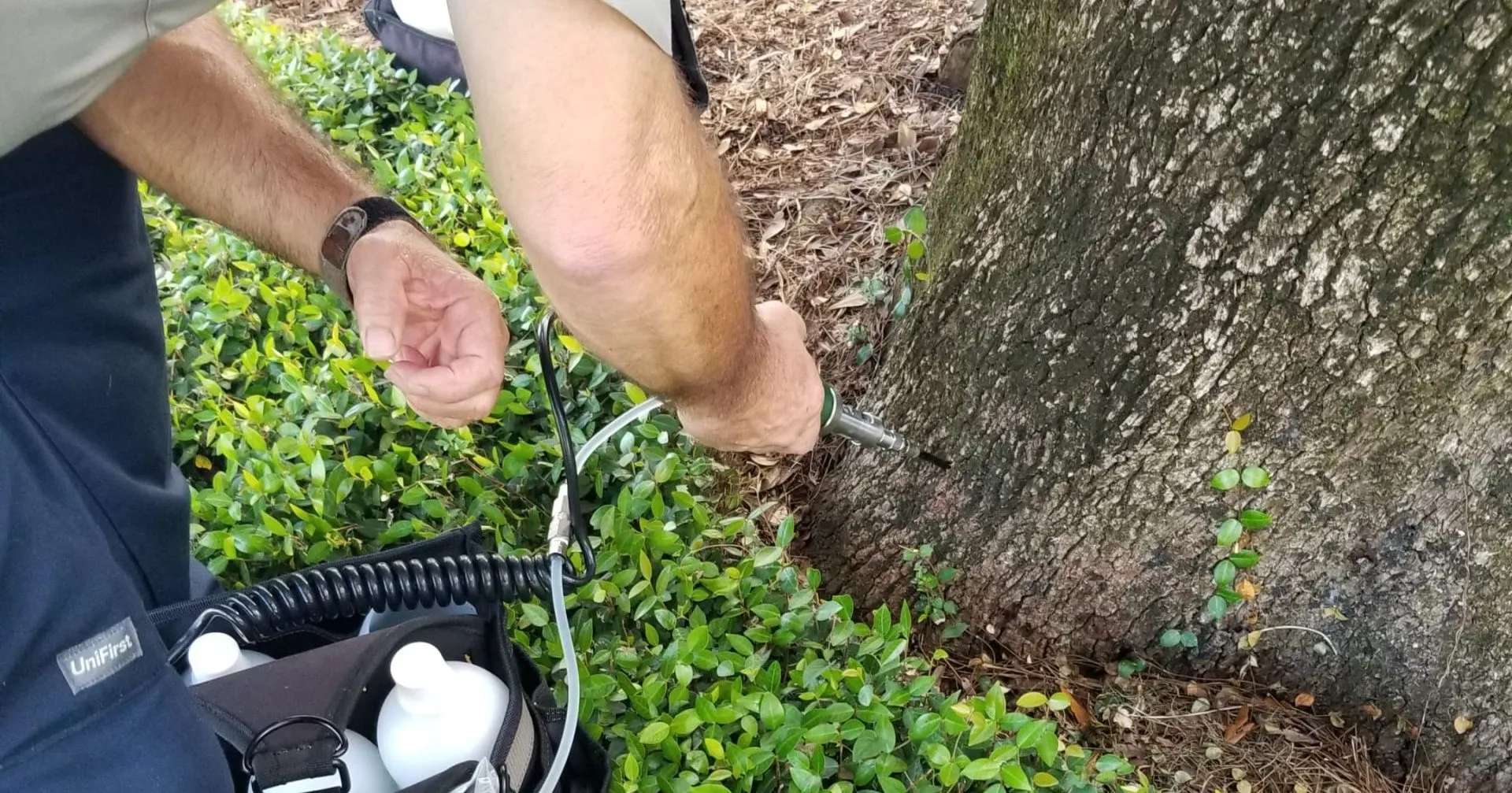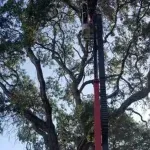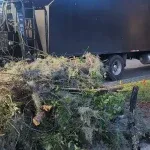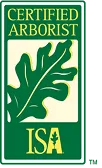
June 14, 2019
Mushrooms can be found growing in lots of places. As you know, some mushrooms can even be eaten and enjoyed! However, if you see mushrooms growing at the base of your tree, is it a bad thing? While not all fungus is bad, one type of mushroom fungus you should look out for is honey fungi.
Honey fungi are mushrooms that are yellowy brown in color with a white ring around their stems. They grow in clusters and have a flat top. They can be found at the base of trees or growing around a tree’s roots. They even smell sweet.
Although they may look harmless, honey fungi can make a tree develop problems. These fungi can cause a tree’s leaves to be smaller and paler; it also can cause the tree to have an early leaf drop and change the growth of flowers and fruit. Usually, with honey fungi, you will also see a white fungus appear underneath the tree’s bark.
Honey fungi commonly grow around oak, birch, and fruit trees. It spreads underground. Over time, this type of fungus decays a tree’s roots and can even kill the roots. It eats away at the bark on the roots and base, which can make the tree unstable. Sadly, once this fungus has penetrated the roots, it can be hard to control.
What Mushrooms at the Bottom of a Tree Really Mean
Mushrooms are only the reproductive structures of fungi. The real organism lives underground or inside wood as a network of tiny threads called mycelium. When conditions are right, the mycelium produces to release spores and spreads further.
When it appears at the base of a tree, it usually means the fungus has already colonized part of the tree’s roots or trunk. This colonization does not happen overnight. Fungi often invade through wounds, damaged roots, or weakened wood. Once inside, they feed on cellulose and lignin, two major components of wood.
Four Main Reasons for Mushrooms at the Base
- Root decay: Fungi invade damaged or stressed roots, feeding on the wood and causing them to lose strength.
- Trunk rot: Cavities or cracks at the base of the trunk allow fungi to enter and break down structural tissue.
- Old buried wood: In some cases, sprouts from leftover stumps or roots underground, even if the standing tree itself is not severely infected.
- Excess moisture: Thrive in damp, shaded environments. Trees with poor drainage or heavy mulching around the base are especially prone to fungal growth.
The key detail is that they rarely appear without decaying wood present. If you see them at the base, they almost always point to some level of decay already happening.
What Types of Mushrooms Commonly Grow at Tree Bases?
Some fungi are more dangerous than others. Identifying them helps determine the level of threat to your tree.
Honey Fungus (Armillaria)
- Grows in dense clusters with honey-colored caps.
- Considered one of the most destructive tree fungi worldwide.
- Attacks roots, causing white rot and eventually killing them.
- Signs include dark rhizomorphs (black root-like structures) spreading in the soil.
Ganoderma (Bracket Fungus)
- Appears as tough, woody shelves attached to the trunk.
- Commonly called “shelf fungus” or “conk.”
- Causes butt rot, which weakens the lower trunk and main roots.
- Trees may look healthy until they suddenly fail during storms.
Artist’s Conk (Ganoderma applanatum)
- A flat, perennial bracket fungus that lasts year-round.
- Surfaces can be scratched like a canvas, hence the name “artist’s conk.”
- Indicates advanced internal decay that is not reversible.
Other Mushrooms
- Puffballs, shaggy manes, or ink caps may grow near tree bases.
- While not always as destructive, their presence usually means organic matter is breaking down nearby.
The species matters, but in nearly all cases at the base are a red flag for tree health.
Are Mushrooms at the Base of a Tree Dangerous?
At first glance, mushrooms may seem harmless, but their presence has important implications.
Risks to the Tree
- Loss of stability: Decayed roots and trunk tissue reduce anchorage, making the tree more likely to fall.
- Weakened vascular system: The fungus disrupts the flow of water and nutrients from roots to leaves.
- Reduced vitality: Trees under fungal attack may show thinning canopies, smaller leaves, and increased vulnerability to pests.
- Hidden damage: The tree might look healthy on the outside but could be structurally unsound inside.
Risks to People and Property
- A weakened tree is a safety hazard. Large branches can snap without warning.
- Entire trees can topple during storms, causing damage to houses, cars, fences, or power lines.
- In public areas, such as parks and playgrounds, decayed trees pose liability risks.
How Can You Prevent Harmful Fungi from Spreading?
Fungal growth can seriously damage a tree’s roots and structure if not caught early. Whether it’s honey fungus or another type of harmful decay, there are several steps you can take to prevent it from spreading.
- Avoid overwatering your trees. Excess moisture creates the perfect environment for fungi to thrive.
- Trim and remove dead or diseased branches quickly. Decaying wood invites fungal spores and weakens healthy growth.
Honey fungus cannot be treated with regular fungicides, and removing visible mushrooms will not solve the problem since the fungus spreads through underground rhizomorphs.
If you notice mushrooms or fungal clusters growing at the base of your tree, contact a certified arborist right away. A professional can identify whether the fungus is harmless or destructive. Some infections can be contained, and in certain cases, the tree can even be saved through soil management or transplanting.
Never ignore signs of fungi. The earlier you catch an infection, the better chance your tree has to recover and prevent the spread to nearby plants.
At Bushor’s Tree Surgeons, our team can accurately diagnose whether your tree is affected by harmful fungi. We’ll determine if it’s a “good” or “bad” species and recommend the safest solution. Even if your tree looks healthy, regular inspections ensure it’s not silently suffering below the surface.
Our experienced arborists will do everything possible to preserve your tree. If the infection is too advanced, we can safely remove the affected tree to protect the rest of your landscape.
FAQs About Mushrooms at the Base of Trees
Are mushrooms at the base of a tree always bad?
In most cases, yes. Growing at the base of a tree usually means internal decay, root rot, or compromised structure. While they sometimes sprout from buried roots or stumps, their presence almost always indicates decaying wood nearby.
Do mushrooms kill trees or just grow near them?
They themselves do not kill trees. They are the fruiting bodies of fungi. The real problem is the fungus inside the wood, which feeds on tree tissue and weakens its structure over time. Left unchecked, this can lead to decline or sudden failure.
How long can a tree survive with fungal decay?
It depends on the type of fungus, the tree’s health, and where the decay is located. Some trees may survive for years with localized decay, while others fail quickly once structural roots or the trunk base are compromised. Only a certified arborist can assess stability.
Are mushrooms at the base dangerous for pets or children?
Yes, some mushroom species are toxic if ingested, even in small amounts. While most are not harmful to touch, pets and children should always be kept away from the base of a tree.
When should I call an arborist if I see mushrooms at my tree’s base?
Call a certified arborist as soon as you spot a tree base. They can identify the fungus, test for decay, and determine whether the tree is safe to keep or needs removal. Acting early prevents safety hazards and costly damage.
Hire a Tree Service in Jacksonville, FL
Don’t let your trees suffer! Our Bushor’s Tree Surgeons team will evaluate your potentially sick tree (or trees) and let you know how damaged they are and if they can be saved. With four certified arborists on our team, we know how to care for trees in distress in Florida and the Jacksonville area. We can spot good and bad fungi easily.
We’ve been in the tree business for more than 50 years. If you need a diagnosis of conditions for your trees, Bushor’s Tree Surgeons are at your service.
We are a tree service company based in Jacksonville, Florida, and service customers in Ponte Vedra Beach and St. Augustine, Florida. Call us at (904) 789-8884 or click our contact page to learn more and set up an appointment with one of our certified arborists.






